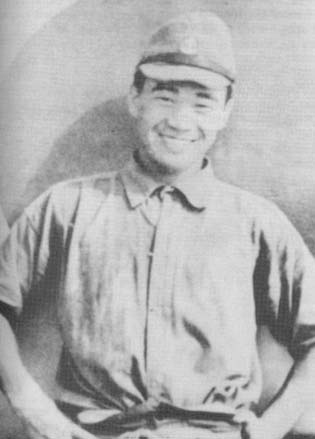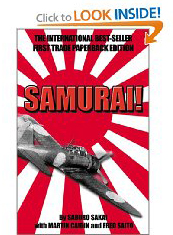The enemies we dealt with in past wars receive little respect. They may have been passionate, dedicated citizens of their motherland, but they were the enemy. Reviled, simply the enemy.
Their exploits, and heroism, and sacrifice, their love and belief in their country, all lost on us.
We hated them. The Enemy!
Then it’s over. The horror ends and we want out; out of the memory, out of the hurt and out of the loss.
We just want to forget.
Inevitably the hurt ebbs, memory dims, and we hear stories; of hurt, and anguish, and loss suffered by the ‘other side’.
Not stories of the politicians and idealists that decided war was the only way, but stories of men measuring their honor against their fears.
 In 1942 one such man was Saburo Sakai, fighting for his Emperor as a pilot with the Japanese Navy. Sakai’s culture was that of the Samurai. The Japanese child, male and female alike, had the tenant duty of the Samurai ingrained from birth. For a thousand years, even into the 1900’s, the Samurai held that the path of the warrior was one of honor, with an emphasis on duty to one's master, and loyalty unto death. In 1942 one such man was Saburo Sakai, fighting for his Emperor as a pilot with the Japanese Navy. Sakai’s culture was that of the Samurai. The Japanese child, male and female alike, had the tenant duty of the Samurai ingrained from birth. For a thousand years, even into the 1900’s, the Samurai held that the path of the warrior was one of honor, with an emphasis on duty to one's master, and loyalty unto death.
In that context Sakai fought for his country, right or wrong.
Sakai was trained as an aviator during 1937. Such an exceptional pilot and Petty Officer was Sakai that he graduating at the head of his class and was awarded a silver watch, which was presented to him by Emperor Herohito himself.
Japan was already at war throughout South East Asia and over the years Sakai saw combat against the Russian, Chinese and Australians as well as the Americans. Although the records show his victories in the air number more than sixty, he never claimed one, and took pride only in the fact that he never lost a wingman in combat, an amazing feat as he often flew with two wingmen.
Sakai’s 8 years long combat career certainly ranks among the greats in arial warfare, but his epic flight home from Guadalcanal on the 8th of August, 1942 defines courage and determination.
 The fierce battle for Guadalcanal raged nearly seven months. From August 1942 into February 1943, Allied forces fought for control on the ground, sea, and in the air. This was the first major offensive launched against the Empire of Japan. The fierce battle for Guadalcanal raged nearly seven months. From August 1942 into February 1943, Allied forces fought for control on the ground, sea, and in the air. This was the first major offensive launched against the Empire of Japan.
On the second day of the battle, Sakai found himself leading flights from the Japanese stronghold of Rabaul. But Rabaul is 640 miles North and West of Guadalcanal, resulting in flights of four hours to the battle, then, spent of ammunition and fuel, four hours home.
On that day, Sakai with two wingmen, closed from behind on what appeared to be a flight of Grumman F-4 Wildcats. But these were no Wildcats. This was a flight of the newly introduced Grumman TBM Avenger, each with two rear facing machine gun turrets. At the last moment, realizing the threat but closing rapidly, Sakai called for both his wingmen to veer off. Covering their escape, Sakai opened fire and flew right through the hail of machine gun fire.
The ventral gunner on the Avenger flown by U.S.N. Ensign Robert Shaw caught Sakai’s Zero squarely, shattering his canopy and severely injuring Sakai.
Unconscious, his Zero diving toward the sea, Sakai came too unable to see. Blinded in the right eye from a bullet that had passed through his skull and the right side of his brain leaving his entire left side paralyzed, and unable to see out of his good eye due to blood flowing from the head wound, Sakai's vision cleared just enough to allow him to recover. Thus began an oddesy of determination and courage which would last nearly five hours as Sakai, drifting in and out of consciousness, weakening from loss of blood, in sever pain from a broken scull and wounds to his arms and legs, his entire left side paralyzed and flying a crippled Zero with it’s canopy shot away, attempted to return home to Rabaul.
In his book “Samurai” written with Martin Caiden
after the war, Sakai discribes his flight, his landing attempts
upon reaching Rabaul, and his many months spent in recovery.
Incredibly, with Japan’s war on the ropes and criticaly
short of combat pilots, Sakai would return not just to the
cockpit, but eventually back into combat as well.
|


 In 1942 one such man was Saburo Sakai, fighting for his Emperor as a pilot with the Japanese Navy. Sakai’s culture was that of the Samurai. The Japanese child, male and female alike, had the tenant duty of the Samurai ingrained from birth. For a thousand years, even into the 1900’s, the Samurai held that the path of the warrior was one of honor, with an emphasis on duty to one's master, and loyalty unto death.
In 1942 one such man was Saburo Sakai, fighting for his Emperor as a pilot with the Japanese Navy. Sakai’s culture was that of the Samurai. The Japanese child, male and female alike, had the tenant duty of the Samurai ingrained from birth. For a thousand years, even into the 1900’s, the Samurai held that the path of the warrior was one of honor, with an emphasis on duty to one's master, and loyalty unto death. The fierce battle for Guadalcanal raged nearly seven months. From August 1942 into February 1943, Allied forces fought for control on the ground, sea, and in the air. This was the first major offensive launched against the Empire of Japan.
The fierce battle for Guadalcanal raged nearly seven months. From August 1942 into February 1943, Allied forces fought for control on the ground, sea, and in the air. This was the first major offensive launched against the Empire of Japan.
